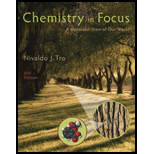
Concept explainers
Billions of pounds of urea,
By assuming unlimited amounts of CO2, how many moles of urea can be produced from each of the following amounts of
Interpretation:
The number of moles of urea is to be determined in the given amounts of
Concept introduction:
The characteristic mass of a compound is the formula mass of the compound, which is obtained by adding the atomic masses of all atoms.
A conversion factor is a numerical ratio, which is used to change one unit into another.
The chemical formula represents the precise number of atoms in a molecule, but not their structural arrangement.
Answer to Problem 54E
Solution: The number of moles of urea present in the molecules is given as follows:
Explanation of Solution
a)
The equivalence is obtained between moles of
In order to obtain the moles of urea, the conversion factor proceeds as follows:
Therefore, the number of moles of urea is
b)
The equivalence is obtained between moles of
In order to obtain the moles of urea, the conversion factor proceeds as follows:
Therefore, the moles of urea are
c)
The equivalence is obtained between grams of
The equivalence is obtained between moles of
In order to obtain the moles of urea, the conversion factor proceeds as follows:
Here,
Therefore, the moles of urea are
d)
The equivalence is obtained between grams of
The equivalence is obtained between moles of
In order to obtain the moles of urea, the conversion factor proceeds as follows:
Here,
Therefore, the moles of urea are
Want to see more full solutions like this?
Chapter 4 Solutions
Chemistry In Focus
- (a) Butane gas, C4H10, can burn completely in air [use O2(g) as the other reactant] to give carbon dioxide gas and water vapor. Write a balanced equation for this combustion reaction. (b) Write a balanced chemical equation for the complete combustion of C3H7BO3, a gasoline additive. The products of combustion are CO2(g), H2O(g), and B2O3(s).arrow_forward3.92 Many chemical reactions take place in the catalytic con- verter of a car. In one of these reactions, nitric oxide (NO) reacts with ammonia (NH3) to give nitrogen (N2) and water. Write a balanced equation for this reaction.arrow_forward4.8 In an experiment carried out at very low pressure, 13x1015 molecules of H2 are reacted with acetylene, C2H2, to form ethane, C2H6, on the surface of a catalyst. Write a balanced chemical equation for this reaction. How many molecules of acetylene are consumed?arrow_forward
- Many cereals are made with high moisture content so that the cereal can be formed into various shapes before it is dried. A cereal product containing 58% H2O by mass is produced at the rate of 1000. kg/h. What mass of water must be evaporated per hour if the final product contains only 20.% water?arrow_forward4.21 Ammonium nitrate, NH4NO3, will decompose explosively to form N2, O2, and H2O, a fact that has been exploited in terrorist bombings. What mass of nitrogen is formed by the decomposition of 2.6 kg of ammonium nitrate?arrow_forwardThe sugar sucrose, which is present in many fruits and vegetables, reacts in the presence of certain yeast enzymes to produce ethanol and carbon dioxide gas. Balance the following equation for this reaction of sucrose. C12H22O11(aq) + H2O(l) C2H5OH(aq) + CO2(g)arrow_forward
- High cost and limited availability of a reactant often dictate which reactant is limiting in a particular process. Identify the limiting reactant when the reactions below are run, and come up with a reason to support your decision. a. Burning charcoal on a grill: C(s)+O2(g)CO2(g) b. Burning a chunk of Mg in water: Mg(s)+2H2O(l)Mg(OH)2(aq)+H2(g) c. The Haber process of ammonia production: 3H2(g)+N2(g)2NH3(g)arrow_forwardMethane (CH4) is the main component of marsh gas. Heating methane in the presence of sulfur produces carbon disulfide and hydrogen sulfide as the only products. a. Write the balanced chemical equation for the reaction of methane and sulfur. b. Calculate the theoretical yield of carbon disulfide when 120. g of methane is reacted with an equal mass of sulfur.arrow_forward77. Explain why the equivalent weight of H2SO4 is half the molar mass of this substance. How many hydrogen ions does each H2SO4 molecule produce when reacting with an excess of OH ions?arrow_forward
 Chemistry & Chemical ReactivityChemistryISBN:9781133949640Author:John C. Kotz, Paul M. Treichel, John Townsend, David TreichelPublisher:Cengage Learning
Chemistry & Chemical ReactivityChemistryISBN:9781133949640Author:John C. Kotz, Paul M. Treichel, John Townsend, David TreichelPublisher:Cengage Learning Chemistry & Chemical ReactivityChemistryISBN:9781337399074Author:John C. Kotz, Paul M. Treichel, John Townsend, David TreichelPublisher:Cengage Learning
Chemistry & Chemical ReactivityChemistryISBN:9781337399074Author:John C. Kotz, Paul M. Treichel, John Townsend, David TreichelPublisher:Cengage Learning Introductory Chemistry: A FoundationChemistryISBN:9781337399425Author:Steven S. Zumdahl, Donald J. DeCostePublisher:Cengage Learning
Introductory Chemistry: A FoundationChemistryISBN:9781337399425Author:Steven S. Zumdahl, Donald J. DeCostePublisher:Cengage Learning Chemistry for Engineering StudentsChemistryISBN:9781337398909Author:Lawrence S. Brown, Tom HolmePublisher:Cengage Learning
Chemistry for Engineering StudentsChemistryISBN:9781337398909Author:Lawrence S. Brown, Tom HolmePublisher:Cengage Learning Chemistry: The Molecular ScienceChemistryISBN:9781285199047Author:John W. Moore, Conrad L. StanitskiPublisher:Cengage Learning
Chemistry: The Molecular ScienceChemistryISBN:9781285199047Author:John W. Moore, Conrad L. StanitskiPublisher:Cengage Learning Chemistry: Principles and PracticeChemistryISBN:9780534420123Author:Daniel L. Reger, Scott R. Goode, David W. Ball, Edward MercerPublisher:Cengage Learning
Chemistry: Principles and PracticeChemistryISBN:9780534420123Author:Daniel L. Reger, Scott R. Goode, David W. Ball, Edward MercerPublisher:Cengage Learning





